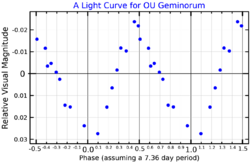Astronomy:OU Geminorum
From HandWiki
Short description: Multiple star system in the constellation Gemini
| Observation data Equinox J2000.0]] (ICRS) | |
|---|---|
| Constellation | Gemini |
| Right ascension | 06h 26m 10.2464s[2] |
| Declination | +18° 45′ 24.896″[2] |
| Apparent magnitude (V) | 6.768[3] |
| Characteristics | |
| Spectral type | K3Vk[3] |
| U−B color index | 0.662[3] |
| B−V color index | 0.972[3] |
| Variable type | BY Dra[4] |
| Astrometry | |
| Radial velocity (Rv) | −8.98±0.10[5] km/s |
| Proper motion (μ) | RA: −124.020±0.097[2] mas/yr Dec.: −159.335±0.054[2] mas/yr |
| Parallax (π) | 68.46 ± 0.34[2] mas |
| Distance | 47.6 ± 0.2 ly (14.61 ± 0.07 pc) |
| Absolute magnitude (MV) | 5.93±0.05[3] |
| Orbit[5] | |
| Primary | OU Gem Aa |
| Companion | OU Gem Ab |
| Period (P) | 6.991878±0.000004 d |
| Eccentricity (e) | 0.151±0.0024 |
| Periastron epoch (T) | 54900.0719±0.0203 JD |
| Argument of periastron (ω) (secondary) | 77.63±1.09° |
| Semi-amplitude (K1) (primary) | 57.09±0.15 km/s |
| Semi-amplitude (K2) (secondary) | 66.22±0.28 km/s |
| Details[6] | |
| OU Gem Aa | |
| Mass | 0.85 M☉ |
| Radius | 0.81 R☉ |
| Surface gravity (log g) | 4.55 cgs |
| Temperature | 4960 K |
| OU Gem Ab | |
| Mass | 0.71 M☉ |
| Radius | 0.65 R☉ |
| Surface gravity (log g) | 4.65 cgs |
| Temperature | 4390 K |
| Other designations | |
| Database references | |
| SIMBAD | data |
OU Geminorum (OU Gem) is a visual binary or possible triple star located in the constellation of Gemini.
The system has an absolute magnitude of 5.93, so at a distance of 48 light years it has an apparent magnitude of 6.77 when viewed from earth. It also has a total proper motion of 0.210"/yr and belongs to the Ursa Major stream.
The system is a much studied BY Draconis variable star with a period of 6.99 days.[4] The primary star has a spectral type of K3Vk. The secondary star in the system has a surface temperature of 4486±50 K and orbits the primary in about seven days.[8][9]
References
- ↑ Bopp, B. W.; Noah, P.; Klimke, A.; Hall, D. S.; Henry, G. W. (August 1981). "Photometry of HD 45088 : a new bright BY DRA variable". Publications of the Astronomical Society of the Pacific 93: 504–506. doi:10.1086/130867. Bibcode: 1981PASP...93..504B.
- ↑ 2.0 2.1 2.2 2.3 2.4 Brown, A. G. A. et al. (2016). "Gaia Data Release 1. Summary of the astrometric, photometric, and survey properties". Astronomy and Astrophysics 595: A2. doi:10.1051/0004-6361/201629512. Bibcode: 2016A&A...595A...2G.Gaia Data Release 1 catalog entry
- ↑ 3.0 3.1 3.2 3.3 3.4 Koen, C. et al. (April 2010). "UBV(RI)C JHK observations of Hipparcos-selected nearby stars". Monthly Notices of the Royal Astronomical Society 403 (4): 1949–1968. doi:10.1111/j.1365-2966.2009.16182.x. Bibcode: 2010MNRAS.403.1949K.
- ↑ 4.0 4.1 Bopp, B. W. (1980). "HD 45088 as a BY Draconis variable". Publications of the Astronomical Society of the Pacific 92: 218–220. doi:10.1086/130651. Bibcode: 1980PASP...92..218B.
- ↑ 5.0 5.1 Glazunova, L. V. et al. (2014). "Absolute parameters and chemical composition of the binary star OU Gem". Monthly Notices of the Royal Astronomical Society 444 (2): 1901–1908. doi:10.1093/mnras/stu1576. Bibcode: 2014MNRAS.444.1901G.
- ↑ Fuhrmann, Klaus (2008). "Nearby stars of the Galactic disc and halo - IV". Monthly Notices of the Royal Astronomical Society 384 (1): 173–224. doi:10.1111/j.1365-2966.2007.12671.x. Bibcode: 2008MNRAS.384..173F.
- ↑ "V* OU Gem". SIMBAD. Centre de données astronomiques de Strasbourg. http://simbad.u-strasbg.fr/simbad/sim-basic?Ident=V%2A+OU+Gem.
- ↑ "Aricns 4C00500". http://www.ari.uni-heidelberg.de/datenbanken/aricns/cnspages/4c00500.htm.
- ↑ "Multiwavelength optical observations of chromospherically active bina…". http://cdsweb.cern.ch/record/411408/files/9912160.pdf.
External links
- Luck, R. Earle (February 2005). "Stars within 15 Parsecs: Abundances for a Northern Sample". The Astronomical Journal 129 (2): 1063–1083. doi:10.1086/427250. Bibcode: 2005AJ....129.1063L.
- Innes, T.V. (1998). "OU Gem and AT Cap IN 1984/5 (Commissions 27 and 42 of the IAU)". Information Bulletin on Variable Stars 4569: 1. Bibcode: 1998IBVS.4569....1I.
- Mishenina, T.V. (2010). "The New Absolute Parameters Of Ou Gem – The star Of By Dra Type". Odessa Astronomical Publications 23: 83. Bibcode: 2010OAP....23...83M.
- University of Hamburg, The. "NEXXUS - Search the Gliese Catalogue". http://www.hs.uni-hamburg.de/~st1h314/starpage.cgi?identifier=0344.
 |


